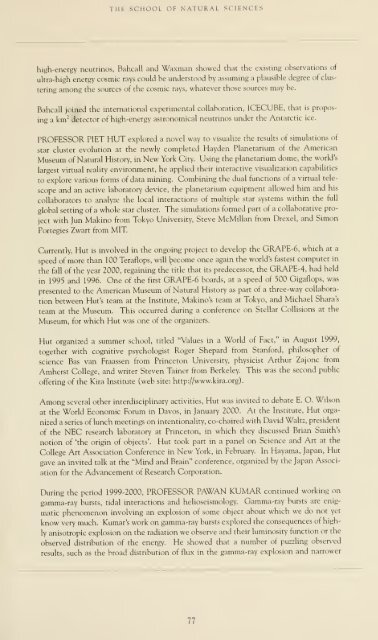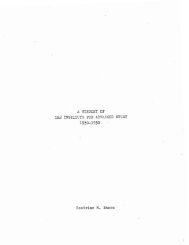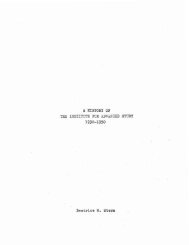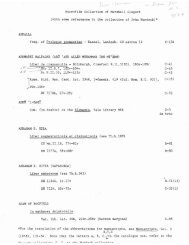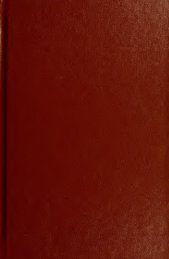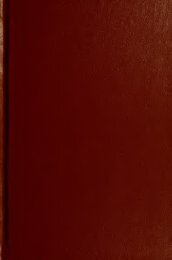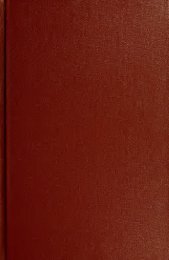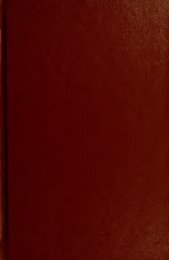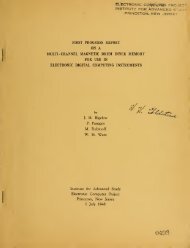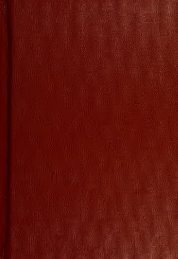Report for the academic year - Libraries - Institute for Advanced Study
Report for the academic year - Libraries - Institute for Advanced Study
Report for the academic year - Libraries - Institute for Advanced Study
Create successful ePaper yourself
Turn your PDF publications into a flip-book with our unique Google optimized e-Paper software.
THE SCHOOL OF NATURAL SCIENCES<br />
high-energy neutrinos, Bahcall and Waxman showed that <strong>the</strong> existing observations of<br />
ultra-high energy cosmic rays could be understood by assuming a plausible degree of clus-<br />
tering among <strong>the</strong> sources of <strong>the</strong> cosmic rays, whatever those sources may be.<br />
Bahcall joined <strong>the</strong> international experimental collaboration, ICECUBE, that is propos-<br />
ing a km 2<br />
detector of high-energy astronomical neutrinos under <strong>the</strong> Antarctic ice.<br />
PROFESSOR P1ET HUT explored a novel way to visualize <strong>the</strong> results of simulations of<br />
star cluster evolution at <strong>the</strong> newly completed Hayden Planetarium of <strong>the</strong> American<br />
Museum of Natural History, in New York City. Using <strong>the</strong> planetarium dome, <strong>the</strong> world's<br />
largest virtual reality environment, he applied <strong>the</strong>ir interactive visualization capabilities<br />
to explore various <strong>for</strong>ms of data mining. Combining <strong>the</strong> dual functions of a virtual tele-<br />
scope and an active laboratory device, <strong>the</strong> planetarium equipment allowed him and his<br />
collaborators to analyze <strong>the</strong> local interactions of multiple star systems within <strong>the</strong> full<br />
global setting of a whole star cluster. The simulations <strong>for</strong>med part of a collaborative project<br />
with Jun Makino from Tokyo University, Steve McMillan from Drexel, and Simon<br />
Portegies Zwart from MIT<br />
Currently, Hut is involved in <strong>the</strong> ongoing project to develop <strong>the</strong> GRAPE-6, which at a<br />
speed of more than 100 Teraflops, will become once again <strong>the</strong> world's fastest computer in<br />
<strong>the</strong> fall of <strong>the</strong> <strong>year</strong> 2000, regaining <strong>the</strong> title that its predecessor, <strong>the</strong> GRAPE-4, had held<br />
in 1995 and 1996. One of <strong>the</strong> first GRAPE-6 boards, at a speed of 500 Gigaflops, was<br />
presented to <strong>the</strong> American Museum of Natural History as part of a three-way collabora-<br />
tion between Hut's team at <strong>the</strong> <strong>Institute</strong>, Makino's team at Tokyo, and Michael Shara's<br />
team at <strong>the</strong> Museum. This occurred during a conference on Stellar Collisions at <strong>the</strong><br />
Museum, <strong>for</strong> which Hut was one of <strong>the</strong> organizers.<br />
Hut organized a summer school, titled "Values in a World of Fact," in August 1999,<br />
toge<strong>the</strong>r with cognitive psychologist Roger Shepard from Stan<strong>for</strong>d, philosopher of<br />
science Bas van Fraassen from Princeton University, physicist Arthur Zajonc from<br />
Amherst College, and writer Steven Tainer from Berkeley. This was <strong>the</strong> second public<br />
offering of <strong>the</strong> Kira <strong>Institute</strong> (web site: http://www.kira.org).<br />
Among several o<strong>the</strong>r interdisciplinary activities, Hut was invited to debate E. O. Wilson<br />
at <strong>the</strong> World Economic Forum in Davos, in January 2000. At <strong>the</strong> <strong>Institute</strong>, Hut orga-<br />
nized a series of lunch meetings on intentionality, co-chaired with David Waltz, president<br />
of <strong>the</strong> NEC research laboratory at Princeton, in which <strong>the</strong>y discussed Brian Smith's<br />
notion of '<strong>the</strong> origin of objects'. Hut took part in a panel on Science and Art at <strong>the</strong><br />
College Art Association Conference in New York, in February. In Hayama, Japan, Hut<br />
gave an invited talk at <strong>the</strong> "Mind and Brain" conference, organized by <strong>the</strong> Japan Associ-<br />
ation <strong>for</strong> <strong>the</strong> Advancement of Research Corporation.<br />
During <strong>the</strong> period 1999-2000, PROFESSOR PAWAN KUMAR continued working on<br />
gamma-ray bursts, tidal interactions and helioseismology. Gamma-ray bursts are enig-<br />
matic phenomenon involving an explosion of some object about which we do not yet<br />
know very much. Kumar's work on gamma-ray bursts explored <strong>the</strong> consequences of high-<br />
ly anisotropic explosion on <strong>the</strong> radiation we observe and <strong>the</strong>ir luminosity function or <strong>the</strong><br />
observed distribution of <strong>the</strong> energy. He showed that a number of puzzling observed<br />
results, such as <strong>the</strong> broad distribution of flux in <strong>the</strong> gamma-ray explosion and narrower<br />
77


